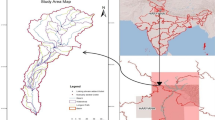Abstract
The effects of climate change on hydrological regimes have become a priority area for water and catchment management strategies. The terrestrial hydrology driven by monsoon rainfall plays a crucial role in shaping the agriculture, surface and ground water scenario in India. Thus, it is imperative to assess the impact of the changing climatic scenario projected under various climate change scenario towards the hydrological aspects for India. Runoff is one of the key parameters used as an indicator of hydrological process. A study was taken up to analyse the climate change impact on the runoff of river basins of India. The global circulation model output of Hadley centre (HADCM3) projected climate change data was used. Scenario for 2080 (A2 scenario indicating more industrial growth) was selected. The runoff was modeled using the curve number method in spatial domain using satellite derived current landuse/cover map. The derived runoff was compared with the runoff using normal climatic data (1951–1980). The results showed that there is a decline in the future climatic runoff in most of the river basins of India compared to normal climatic runoff. However, significant reduction was observed for the river basins in the eastern region viz: lower part of Ganga, Bahamani-Baitrani, Subarnrekha and upper parts of the Mahanadi. The mean projected runoff reduction during monsoon season (June–September) were 18 Billion Cubic Meter (BCM), 3.2 BCM, 3.5 BCM and 5.9 BCM for Brahmaputra-Barak Subarnrekha, Subarnarekha and Brahmini-Baitrani basin, respectively in comparison to normal climatic runoff. Overall reduction in seasonal runoff was high for Subarnrekha basin (54.1%). Rainfall to runoff conversion was high for Brahmaputra-Barak basin (72%), whereas coefficient of variation for runoff was more for Mahanadi basin (1.88) considering the monsoon season. Study indicates that eastern India agriculture may be affected due to shortage of surface water availability.





Similar content being viewed by others
References
Bhuyan, S. J., Mankin, K. R., & Koelliker, J. K. (2003). Watershed scale AMC selection for hydrologic modeling. Transactions of ASAE, 46, 237–244.
Chatterjee, C., Jha, R., Lohani, A. K., Kumar, R., & Singh, R. (2001). Runoff curve number estimation for a basin using remote sensing and GIS. Asian pacific remote sensing and GIS journal, 14, 1–7.
Dhruvnarayan, V. V. (1993). Soil and water conservation research in India. Pusa, New Delhi: ICAR Krishi Anusandhan Bhavan.
Joshi, P. K., Roy, P. S., Singh, S., Agrawal, S., & Yadav, D. (2006). Vegetation cover mapping in India using multi-temporal IRS Wide Field Sensor (WiFS) data. Remote Sensing of Environment, 103, 190–202.
Kumar, P., Tiwari, K. N., & Pal, D. K. (1997). Establishing SCS runoff curve number from IRS digital database. Journal of the Indian Society of Remote Sensing, 19(4), 246–251.
Miloradov, M., & Marjanovic, P. (1991). Geographic information system in environmentally sound river basin development. Delft, the Netherlands: 3 rd Rhine-Danube Workshop. 7–8 October 1991.
Moglen, G. E. (2000). Effect of orientation of spatially distributed curve numbers in runoff calculations. Journal of the American Water Resources Association, 36(6), 1391–1400.
Nayak, T. R., & Jaiswal, R. K. (2003). Rainfall-runoff modelling using satellite data and GIS for Bebas River in Madhya Pradesh. IE (I) Journal, 84, 47–50.
Pandey, V.K., Panda, S.N., Sudhakar, S. (2002) Curve number estimation from watershed using digital image of IRS-1D, LISS III. www.gisdevelopment.net.
Ponce, V. M., & Hawkins, R. H. (1996). Runoff curve number: has it reached maturity? Journal of Hydrologic Engineering ASCE, 1(1), 11–19.
Rao, K. V., Bhattacharya, A. K., & Mishra, K. (1996). Runoff estimation by curve number method-case studies. Journal of Soil and Water Conservation, 40, 1–7.
Sharma, T., Satya Kiran, P. V., Singh, T. P., Trivedi, A. V., & Navalgund, R. R. (2001). Hydrological response of watershed to Landuse changes: Remote sensing and GIS approach. International Journal of Remote Sensing, 22, 2095–2108.
Stott, P. A., Tett, S. F. B., Jones, G. S., Allen, M. R., Mitchell, J. F. B., & Jenkins, G. J. (2000). External control of 20th century temperature by natural and anthropogenic forcings. Science, 290, 2133–2137.
SCS (1972, 1985) Hydrology. National Engineering Handbook, Supplement A, Section 4, Chapter 10. Soil Conservation Service, USDA, Washington, DC.
Schulze, R. E., Schmidt, E. J., & Smithers, J. C. (1992). SCS-SA user manual PC based SCS design flood estimates for small catchments in Southern Africa, report No. 40. Pietermaritzburg, South Africa: Department of Agricultural Engineering University of Natal.
SOI (1978) Soil textural map, Survey of India.
USDA. (1986). Urban Hydrology for Small Watersheds. Springfield, VA: Technical Release 55 National Technical Information Service.
Vandersypen, D. R., Bali, J. S., & Yadav, Y. P. (1972). Handbook of hydrology. New Delhi: Soil Conservation Division, Ministry of Agriculture, Government of India.
Acknowledgement
This work has been carried out under the Earth Observation Applications Mission (EOAM) project on “Water Use in Agriculture”. The authors are thankful to Dr. R. R. Navalgund, Director, Space Applications Centre (SAC) for his support and encouragement.
Author information
Authors and Affiliations
Corresponding author
About this article
Cite this article
Gupta, P.K., Panigrahy, S. & Parihar, J.S. Impact of Climate Change on Runoff of the Major River Basins of India Using Global Circulation Model (HadCM3) Projected Data. J Indian Soc Remote Sens 39, 337–344 (2011). https://doi.org/10.1007/s12524-011-0101-7
Received:
Accepted:
Published:
Issue Date:
DOI: https://doi.org/10.1007/s12524-011-0101-7




